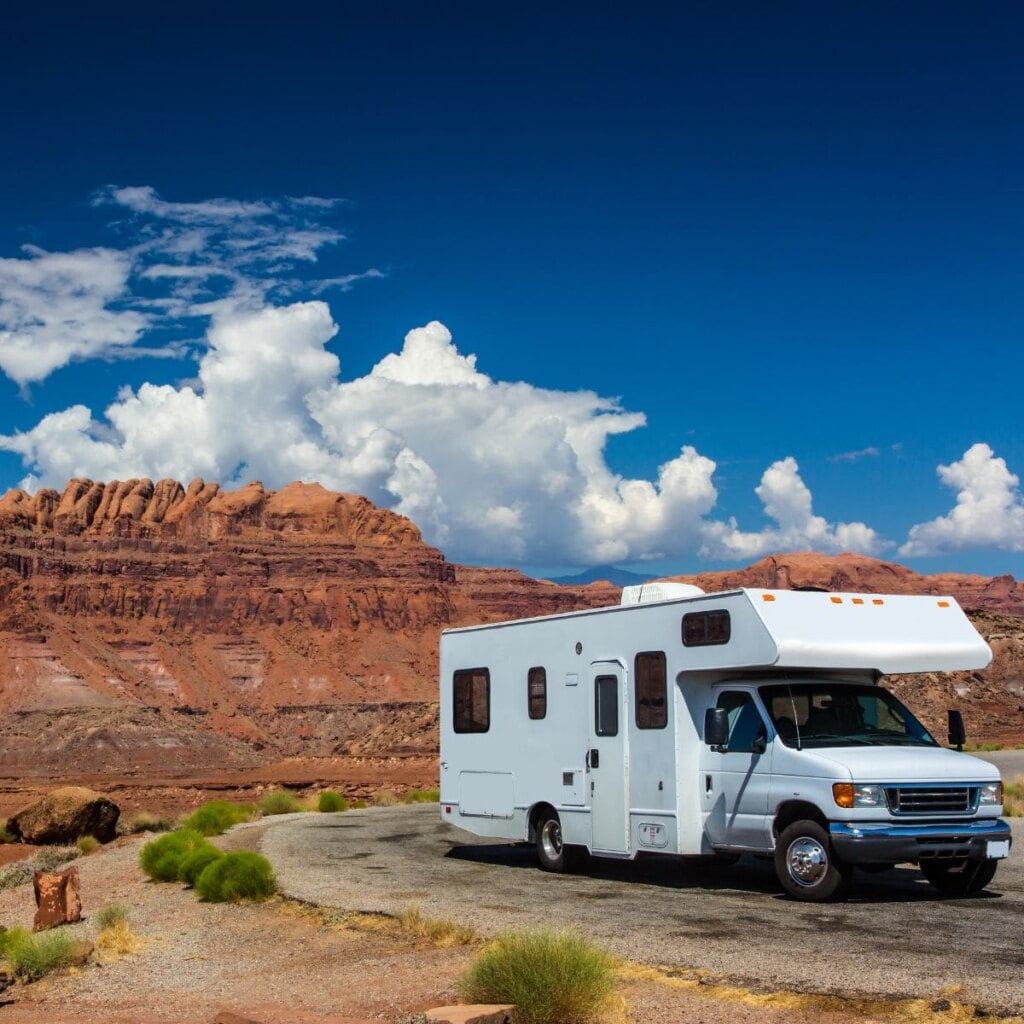Nothing says vacationing freedom like a trip in an RV. With its miles of scenic coastline and rolling hills, and with world-famous forests and rugged mountains within easy driving distance, Southern California is an ideal place to start – or end – a family RV vacation.
If you can’t decide on a single destination or if you and your family like a lot of outdoor activities rather than the structured fun of destination resort hotels, hopping in an RV provides the ultimate in vacation flexibility. When you’re planning a family RV vacation, you can focus on having just as much fun getting there as you do with actually being there.
When you go RVing, you can choose to stay more urban or go up a dirt road to find spectacular camping… nestling your RV along the bluffs down by the beach or winding your way up to Big Bear and Mammoth. With an RV, you can take your family as far as you want to go with all the comforts of home.

Pro-Tip: If you’re looking to get away for a camping trip without having to commit to sleeping in a tent (or if you have medical conditions, like sleep apnea, which require you to sleep with a CPAP machine) an RV with its onboard electrical supply is the way to go.
How Do I Plan My Family RV Vacation?
This is the hard part, because it means narrowing down where you want to go and what you want to see. If you’re interested in taking the kids to see the Grand Canyon or going from Oceanside to Mt. Shasta, you’re going to need think about how long you’re going to be away from home, how much you’re going to be hauling with you, and who you’re going to be bringing with you.
RV vacations are as much about the getting there as they are about the being there… wherever there is.
Your dream destination might be anything from a family friendly campsite in the mountains to a members-only stay at a vineyard or farm… or it could be you and your family cruising along the highways and stopping at every single kitschy roadside stand and drive-through attraction on your way to Texas. Either way, renting an RV is going to make the going more comfortable.
Pro-Tip: For families who want to travel with pets or who have kids who have special needs, the steady familiarity of your RV makes taking a trip easier.
If you’re having trouble narrowing down where you’d want to drive to, try picking a destination from a favorite book, or that reminds you of a favorite family story. Maybe one of your kids has always wanted to go camping in the mountains, or maybe the idea of cruising up to Solvang sounds good. Ask your family what they’d like to do: one of your kids might have a secret desire to camp in the desert to stargaze and you just never knew!
Pro-Tip: It’s easy to think about how long it takes to drive to your campsite, but it’s just as easy to forget about how long it takes to get home. When you’re budgeting for time, make sure you’re allowing for the round trip.
There’s an App for That!
Once you have a destination (or several destinations), it’s serious planning time. Fortunately, there are several online resources for planning your next RV trip:
- Good Sam lets you search RV parks by type, from adventure destinations to family friendly RV resorts and more. It offers a membership option that includes a bundle of helpful things like their exclusive trip planner, emergency medical services, and transportation assistance in case of illness or injury.
- RV Trip Wizard is a web-based visual trip planner with unbiased information and comprehensive coverage of everything you need to know about the route you’re planning to take and the campsites you’re planning to stay at. There’s also a companion app from RV Life that makes planning any trip super easy.
OK, Now Where do I Get an RV?
Once you’ve got your itinerary, you need that RV.
If you don’t own one outright or have a friend you can borrow from, don’t worry. There are plenty of places that will rent you the perfect RV for your family vacation.
The bigger companies are:
- Cruise America: corporate option; does 1-way trip rentals in addition to traditional round-trip rentals. Covers the continental US, Alaska, and Canada.
- Outdoorsy: a peer-to-peer rental service with a super easy interface. Search for exactly what you want to rent.
- RV Share: a peer-to-peer rental option. The service offers 24 hr. Travel concierge service and roadside assistance when you book your RV rental online. Their site also gives you valuable information about your destinations, like hike difficulty.
- RVnGo is a fee-free peer-to-peer site that lets you search for the RV you need by destination. They also offer 24 hr. Roadside assistance. This company specifically mentions ADA compliant, wheelchair accessible, and pet friendly RV options.
If you prefer a smaller company, there’s always:
- El Monte RV Rentals in Newport Beach
- ShareMyCoach in Stanton
How Do I Know What Size of RV I Need?
Since this is a family trip, space is going to be a consideration. You want enough so that you’re all comfortable, so let’s talk classifications for a minute.
Motorcoaches are exactly what they sound like; mobile homes that you drive. They’re probably what you most commonly associate with an RV trip. The second classification is for towables, which is where you’ll find your travel trailers and pop-up campers.
Which type of RV you’ll choose depends on whether your family is two adults or two adults and more than one kidlet running around.
Class A RVs
The grande dame of mobile living, this is the biggest type of RV and the one that sleeps the most people. If you’ve got a big family or are travelling with extended family – and know what you’re doing – this is the RV for you.
Class A RVs go from 20 feet to 45 feet, and as you can imagine, aren’t great in the gas mileage department. This is the luxury option for RV ownership (or rental). It can be configured to sleep 8-10 people (maybe more), and usually has full-size appliances, fancy pull-out sofas, and large closets.
Fuel: gas or diesel. Smaller motorcoaches can run on gas.
- Pros: You’re literally bringing your house with you, so you’ll be supremely comfortable. The living space is more customizable and there’s generally enough room for everything. Class A RVs usually has a generator but always has utility connections so you can hook into campground power. There are onboard plumbing systems and holding tanks for water.
- Cons: Maneuverability is a little like herding cats… if cats were the size of a tour bus; negligible gas mileage.
Class B RVs
The most flexible option, Class Bs are self-powered and aren’t big on packing on the amenities. What you’re giving up in closet space and full-scale kitchens (although you can definitely find Class B RVs with kitchenettes, much like you’d find on sailboats) you’re gaining in the ability to go anywhere, including the less well-paved roads. This is best for a small family, because you’re going to be sharing close quarters.
- Pros: Flexibility to go to more remote campsites.
- Cons: Not exactly luxurious. Sleeps the fewest out of the motorcoach options.
Class C RVs
The classic RV, Class C’s offer the most options in terms of space, luxury points, and comfortable living. They’re flexible enough to handle most families, and the easiest to drive out of the three motorcoach classes.
- Pros: Familiar to drive, easier to maneuver, most flexible in terms of the number of people you can fit in them. If you’re renting a motorcoach, Class Cs will give you the best balance of features, space, amenities and overall performance.
- Cons: You do have to give it back when you’re done.
If you’re a newbie to RVing (hey, everyone has to start somewhere, right?) you should keep your choices to these classes, since they’re smaller (for an RV). If you’ve ever moved into minivan territory from driving a coupe or sedan, you know the awkwardness of trying to park something that’s a lot bigger than what you’re used to driving. Except, with an RV, it’s a lot bigger.
If a motorcoach is a little rich for your wallet, there’s always the travel trailer class of RV. Chances are good that you’ve seen a lot of these as you sit in traffic.
This version of an RV isn’t self-propelled, so you do need a vehicle with a powerful enough engine to tow it. If you’re already the proud owner of a good-sized pickup truck, go ahead and look at renting or borrowing a travel trailer.
Most Fuel-efficient RVs
There really isn’t any such creature, because an RV is a large vehicle that weighs a lot even before you start adding people and supplies to the mix. The most fuel-efficient, though, are going to be the lighter Class Bs and C’s.
What You Need to Rent an RV
Here’s what you don’t need: a CDL. A standard current driver’s license will do fine.
Pro-tip: Do check to see if your auto insurance already covers RVs. Most commercial rental companies will offer insurance if yours doesn’t. You can also purchase RV insurance through AAA.
You can’t rent an RV if you are under 21 years old, and you probably can’t rent one if you’re under 25 (there might be ways to legally bypass this; check with your rental company). You can’t use a temporary license to rent one, either.
Depending on the rental company, you might need to give credit references or have your employment verified.
Ready… Set… Road Trip!
Planning a family RV vacation is more accessible and affordable than you think.
Whether your family is large, small, or just you and your pets, there are plenty of local options available for finding the perfect RV for your vacation so you can join the Great American Road Trip club and build the kind of family memories that will last a lifetime.
Related Articles
| Campgrounds In Orange County | Beach Camping In California |
| Best California Roadside Attractions | Best State Parks In California |
| Best Spots For Glamping In California | Best California National Parks |

